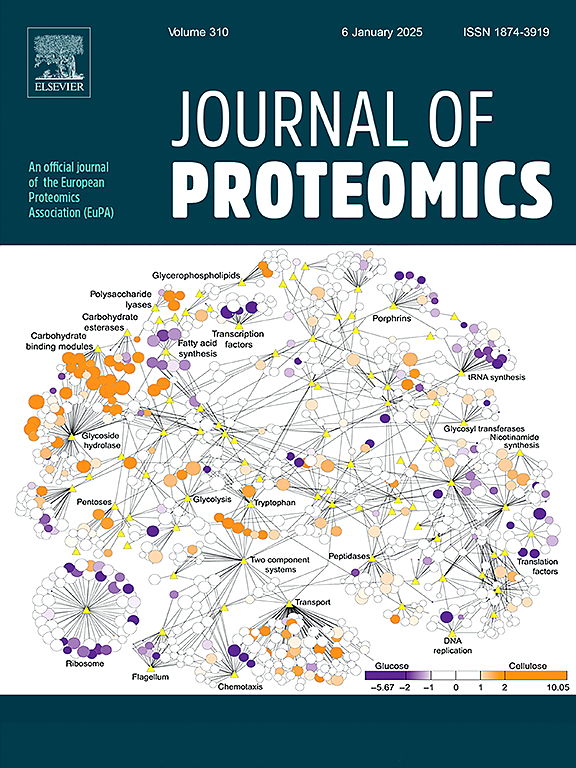Trypanosoma cruzi cell cycle progression exhibits minimal variation in histone PTMs with unique histone H4 acetylation pattern
IF 2.8
2区 生物学
Q2 BIOCHEMICAL RESEARCH METHODS
引用次数: 0
Abstract
Histones are crucial proteins in eukaryotic cells that undergo extensive posttranslational modifications (PTMs) such as methylation, acetylation, and phosphorylation, which are associated to chromatin structure, gene expression, DNA damage/repair and cell cycle. In Trypanosoma cruzi, the primary sequence of histones differs from that of other eukaryotes. Despite this, they display a vast range of PTMs, though their modulation throughout the cell cycle remains largely unexplored. In this study, we investigated the dynamic modulation of histone PTMs across G1/S, S, and G2/M phases of T. cruzi cell cycle using hydroxyurea- synchronized parasites. We applied a workflow that included histone derivatization, trypsin digestion followed by a high-resolution mass spectrometry and data independent analysis. Quantitative analysis of 141 histone peptide isoforms revealed that there are only minor variations in histone PTM levels throughout the cell cycle. The H3K76 trimethylation remained predominant throughout all phases, with an increase in monomethylation during G2/M. Additionally, hyperacetylation of the N-terminal region of histone H4 was observed, particularly at lysine residues 2, 5, and 10, suggesting their importance in cell cycle progression. Striking, acetylation of histone H4 at K2 and K5 increases during the S-phase, mirroring the H4K5acK12ac pattern observed in mammals, which are related to histone nuclear import and chromatin deposition.
Overall, the results suggest that the T. cruzi cell cycle maintains stable global levels of histone PTMs, relying on variations in only a few specific PTMs. Further investigations are warranted to elucidate the functional significance of these PTMs and their impact on cell cycle regulation and chromatin dynamics in T. cruzi.
Significance
Histone posttranslational modifications (PTMs) are key regulators of chromatin architecture and cellular processes such as gene expression and cell cycle control. In Trypanosoma cruzi, the etiological agent of Chagas disease, histones have a distinct primary structure compared to other eukaryotes, yet they display a wide variety of PTMs. This study provides a comprehensive analysis of histone PTM dynamics across the G1/S, S, and G2/M phases of the T. cruzi cell cycle, revealing that global histone PTM levels remain largely stable, with variations in a few specific marks. Notably, the study highlights the increased acetylation of histone H4 at lysines 2 and 5 during the S-phase, contrasting with the well-conserved acetylation at lysines 5 and 12 observed in mammals involved in nuclear import and chromatin assembly. These findings underscore the evolutionary divergence and functional specificity of histone modifications and provide a foundation for further investigations into their roles in parasite biology, with potential implications for understanding chromatin dynamics and identifying novel therapeutic targets.

克氏锥虫细胞周期进展表现出具有独特组蛋白H4乙酰化模式的组蛋白PTMs的最小变化
组蛋白是真核细胞中发生大量翻译后修饰(PTMs)的关键蛋白,如甲基化、乙酰化和磷酸化,与染色质结构、基因表达、DNA损伤/修复和细胞周期有关。在克氏锥虫中,组蛋白的初级序列不同于其他真核生物。尽管如此,它们显示了广泛的ptm,尽管它们在整个细胞周期中的调制仍然在很大程度上未被探索。在本研究中,我们利用羟基脲同步寄生物研究了组蛋白PTMs在克氏t细胞周期G1/S、S和G2/M期的动态调节。我们采用的工作流程包括组蛋白衍生化,胰蛋白酶消化,然后是高分辨率质谱分析和数据独立分析。对141个组蛋白肽亚型的定量分析显示,在整个细胞周期中,组蛋白PTM水平只有很小的变化。在G2/M期间,H3K76三甲基化仍占主导地位,单甲基化有所增加。此外,观察到组蛋白H4 n端区域的超乙酰化,特别是赖氨酸残基2、5和10,表明它们在细胞周期进程中的重要性。令人震惊的是,组蛋白H4在K2和K5位点的乙酰化在s期增加,这反映了在哺乳动物中观察到的H4K5acK12ac模式,这与组蛋白核输入和染色质沉积有关。总的来说,结果表明克氏t细胞周期维持稳定的组蛋白PTMs的全球水平,仅依赖于少数特定PTMs的变化。需要进一步的研究来阐明这些ptm的功能意义及其对克氏t细胞周期调控和染色质动力学的影响。组蛋白翻译后修饰(PTMs)是染色质结构和细胞过程如基因表达和细胞周期控制的关键调控因子。在恰加斯病的病原克氏锥虫中,与其他真核生物相比,组蛋白具有独特的初级结构,但它们表现出多种多样的ptm。本研究对克氏t细胞周期的G1/S、S和G2/M期组蛋白PTM动态进行了全面分析,揭示了全球组蛋白PTM水平在很大程度上保持稳定,只有少数特定标记发生变化。值得注意的是,该研究强调了s期组蛋白H4赖氨酸2和5位点的乙酰化增加,而在哺乳动物中观察到的赖氨酸5和12位点的乙酰化则较为保守,涉及核输入和染色质组装。这些发现强调了组蛋白修饰的进化差异和功能特异性,并为进一步研究它们在寄生虫生物学中的作用提供了基础,对理解染色质动力学和确定新的治疗靶点具有潜在的意义。
本文章由计算机程序翻译,如有差异,请以英文原文为准。
求助全文
约1分钟内获得全文
求助全文
来源期刊

Journal of proteomics
生物-生化研究方法
CiteScore
7.10
自引率
3.00%
发文量
227
审稿时长
73 days
期刊介绍:
Journal of Proteomics is aimed at protein scientists and analytical chemists in the field of proteomics, biomarker discovery, protein analytics, plant proteomics, microbial and animal proteomics, human studies, tissue imaging by mass spectrometry, non-conventional and non-model organism proteomics, and protein bioinformatics. The journal welcomes papers in new and upcoming areas such as metabolomics, genomics, systems biology, toxicogenomics, pharmacoproteomics.
Journal of Proteomics unifies both fundamental scientists and clinicians, and includes translational research. Suggestions for reviews, webinars and thematic issues are welcome.
 求助内容:
求助内容: 应助结果提醒方式:
应助结果提醒方式:


